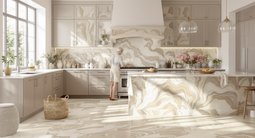TL;DR
Micro-trends like dopamine decor, food-themed accents, and anything “-core” can look great online but age fast at home. If you love maximalist energy, anchor it with timeless interior design style choices and test the rest virtually. ReimagineHome.ai lets you upload one photo, try style recommendations, and preview alternatives in seconds—before you buy a thing.
Why Maximalist Micro‑Trends Matter Right Now

Combine bold trend accents with timeless design for a fresh, enduring interior.
Micro design trends move faster than ever—research shows many interior design trends now average about 10 months before peaking and fading. To keep your modern decor feeling fresh without constant redo’s, balance bold moments with a timeless interior design style and preview every room makeover with AI design tools like ReimagineHome.ai. At a glance - Short trend cycles make high-commitment choices risky; test before buying. - Avoid literal themes (food decor, novelty motifs) and “-core” extremes. - Keep maximalist personality but ground it with durable materials and classic forms. - Use AI to visualize a room makeover from one photo and compare palettes instantly. - Start small: textiles, art, lamps, and paint samples are low-risk, high-impact. Early CTA: Ready to try it now? Upload a photo and explore styles with ReimagineHome.ai: https://www.reimaginehome.ai/?utm_source=blog
10 months: What’s Driving This Design Trend (and the Backlash)

Maximalist trend backlash: Balance boldness with natural textures and muted palettes for longevity.
Research shows interior design trends today have an average lifespan of roughly 10 months—compressed by social media cycles and fast product drops. That pace rewards novelty (dopamine decor, weirdcore, sardine-tin everything) but punishes longevity, making it easy to overspend on a look that dates by next season. What’s driving the swing? First, identity: Gen Z and younger millennials use bold color and maximalist layering to differentiate from the millennial grey era. Second, access: endless home design inspiration makes it simple to try a look overnight. Third, cost-of-living reality: people want a quick mood boost at home—even if it’s a temporary fix. The tension shows up in the DMs designers see most: How do I choose an interior design style I won’t regret? Which trending interior design styles 2025 actually last? How do I keep a small space from feeling chaotic? The consensus: keep your bones and big pieces quiet, then express personality with flexible layers. And when in doubt, prototype with AI first so you can see the difference between an idea and a commitment.
Anecdote
In a 420-square-foot rental, a reader swapped tomato-red pillows, a striped throw, and two prints in and out using AI mockups first; the virtual version that held onto a tan base with one rust accent translated best IRL—bold but calm. In a family dining room, we previewed a citrus palette that felt electric online but skewed neon under warm bulbs; switching to terracotta napkins and an olive runner kept the mood joyful without buzzing. And a coastal kitchen flirting with sardine kitsch landed on pewter hardware and a single indigo lamp—still playful, now timeless.
60–30–10: How This Style Looks in Real Homes Without Regret

Use the 60–30–10 color formula to harmonize bold accents with neutral backgrounds.
The 60–30–10 color rule remains a reliable way to balance saturated accents with neutrals in a modern decor scheme. In practice, it means 60% foundational neutrals (walls, large rug, sofa), 30% supportive tones (curtains, secondary upholstery, wood finishes), and 10% pop (pillows, art, a statement lamp). So what does regret-proof maximalist style actually look like? Think texture before theme. Nubby bouclé against smooth walnut, a ribbed ceramic lamp on honed limestone, a velvet stripe beside a natural-linen solid. Choose shapes with longevity—tailored sofas with slim arms, pedestal side tables, classic drum lampshades—then rotate patterns seasonally. A few lived-in examples: - Dining: keep the table and chairs classic; add a floral runner and saturated linen napkins rather than committing to all-over wallpaper you’ll tire of. - Bedroom: invest in a calm headboard; go bold on shams, a patterned throw, and art that can migrate to another room. - Kitchen: pick timeless slabs and hardware; try color on stools and a pendant shade you can swap. Food-themed decor reads fastest as kitsch—borrow palette (rust, berry, olive) instead of literal motifs. If you adore maximalism, leave negative space. Your eye needs rest lines—blank wall segments, quieter corners, simpler window treatments—to keep layers feeling collected, not crowded.
10 seconds: Modern Tools to Explore Styles (and Why ReimagineHome.ai Wins)

Explore styles instantly with AI tools like ReimagineHome.ai for confident, fast decisions.
AI layout and visualization tools can generate style variations in under 10 seconds, turning hesitation into clarity before you spend. The market spans mood board apps, floor plan tools, 3D walkthrough software, and AI interior design apps—but realism and relevance vary widely. - Mood boards are great for vibe, weak on scale. They don’t show how a pattern reads across your actual wall. - Floor plan and 3D tools are powerful but time-intensive and often require measurements. - Virtual staging tools prioritize real estate marketing, not nuanced style testing. - Style recommendation engines can inspire, yet generic catalogs miss your room’s quirks. What ReimagineHome.ai does differently: you can upload a single photo—no measurements—and get multiple interior style recommendations tailored to your space, with highly realistic lighting, materials, and shadows. It’s fast, intuitive, and backed by large furniture catalogs for credible combinations, like paint color and furniture pairing suggestions. Explore more on the blog: - See how to visualize a room makeover from one photo: https://www.reimaginehome.ai/blogs/one-photo-room-makeover - Compare aesthetics with Scandi vs Japandi insights: https://www.reimaginehome.ai/blogs/scandi-vs-japandi - Find the most accurate AI interior design apps by realism: https://www.reimaginehome.ai/blogs/most-accurate-ai-interior-design-apps
1 photo, 5 minutes: Step‑by‑Step — Try This Style Using ReimagineHome.ai

One photo, five minutes: Achieve bold style transformations easily with AI-powered tools.
You can restyle a room from a single photo with no measurements in about 5 minutes when you use AI design tools designed for realism. Step 1: Upload your photo. Natural daylight works best, but evening shots are fine. Step 2: Pick a direction. Try Maximalist, Minimalist, Boho, or Japandi to compare extremes and hybrids. Step 3: Test palettes. Start with a neutral base, then toggle two bold accents (e.g., saffron + forest) to see which reads richer under your lighting. Step 4: Swap materials. Compare velvet vs linen on the main chair, fluted vs flat-front sideboard, brass vs black hardware. Step 5: Add or remove pattern. Try one statement wallpaper wall virtually, then a version without—notice how your room’s proportions change. Step 6: Save variations and share. Get quick feedback before you buy. Step 7: Act small first. Order textiles and paint samples that match your favorite render; live with them for a week.
Visualization Scenario
Upload your living room photo at golden hour; choose Maximalist and Minimalist variations; toggle a saffron velvet accent chair, then a flax-linen one; compare a gallery wall vs one oversized landscape; save the calmer option for everyday, the bolder for party nights.
FAQ
Q: What trending interior design styles for 2025 feel timeless? A: Japandi, Scandinavian, and warm Minimalist interiors typically outlast micro-trends. Use them as a base, then layer selective maximalist art, color, and textiles for personality. Q: How do I choose an interior design style without chasing micro-trends? A: Audit what you already love—materials, shapes, and colors you never tire of—then test two or three style directions in ReimagineHome.ai. Keep the overlap; skip the outliers. Q: How can I visualize a room makeover from one photo? A: Upload a clear image to ReimagineHome.ai, select a style and palette, and generate realistic variations in seconds. It’s the fastest way to compare options side by side. Q: What are the most accurate AI interior design apps? A: Look for photo-based restyling, large furniture catalogs, and believable lighting/shadows. ReimagineHome.ai focuses on realism so you can trust scale, color, and material reads. Q: Can maximalist decor work in small spaces? A: Yes—limit big pieces to calm finishes, keep 30–36 inches of circulation where possible, and concentrate pattern in movable layers like pillows, throws, and art.
Visualize Your Style’s Next Chapter
One uploaded photo can generate a dozen style variations, turning impulse into informed choice. When the next micro-trend hits your feed, you’ll have a low-risk way to flirt with it, keep what feels authentic, and leave the rest behind. If you’re ready to experiment with confidence, start with your own space: https://www.reimaginehome.ai/?utm_source=blog
.svg)

.svg)














.png)